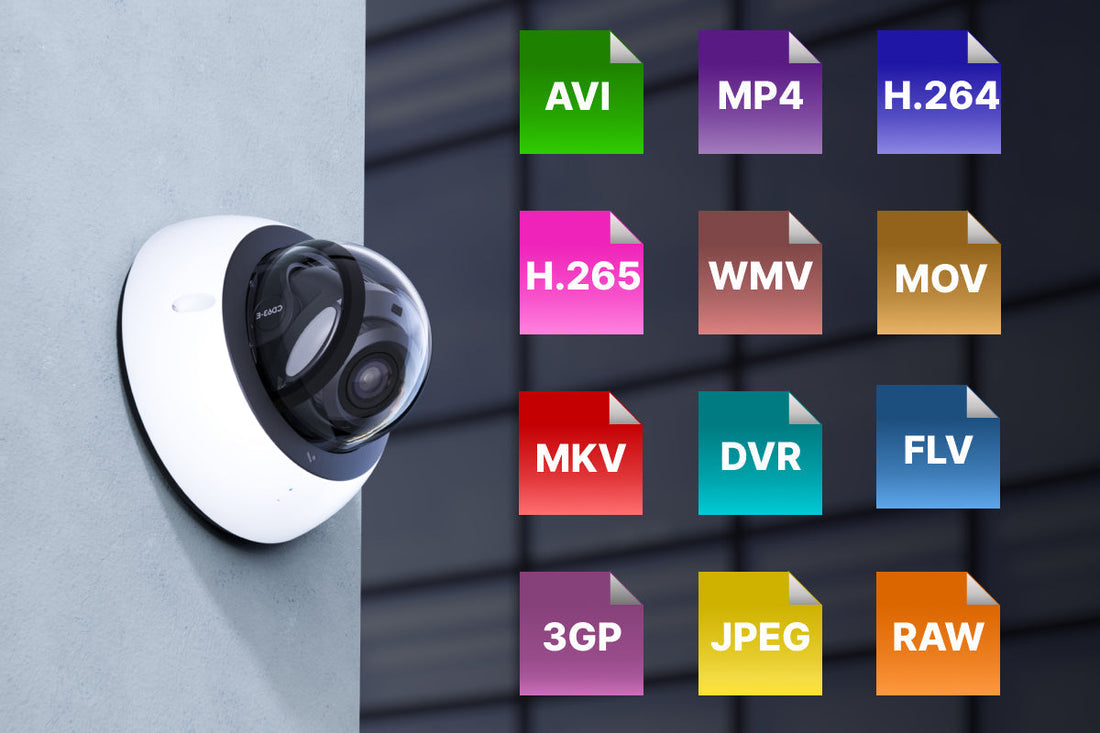
A Complete Guide to CCTV Video File Formats
Share
Different File Formats for CCTV Camera Footage Storage
CCTV cameras are essential in modern security systems, but storing the recorded footage efficiently is just as important as capturing it. The file format used to store surveillance videos can affect the video quality, file size, compression efficiency, compatibility, and ease of access.
With so many options—like AVI, MP4, H.264, H.265, MJPEG, and more—understanding their strengths and limitations will help you choose the best one for your system. Here's a breakdown of the most common file formats used in CCTV camera footage storage, including detailed descriptions and key points for each.
1. AVI (Audio Video Interleave)
AVI is one of the earliest video file formats and is still used in some CCTV systems today. Developed by Microsoft, it supports high-quality video and audio, but with minimal compression. That means AVI files can get very large, making them less ideal for systems with limited storage.
Key Points:
• High video quality with little compression.
• Very large file sizes.
• Compatible with most media players.
• Ideal for short-term storage or detailed forensic review.
2. MP4 (MPEG-4 Part 14)
MP4 is the most commonly used format in modern CCTV systems due to its efficient compression and wide compatibility. It works well for streaming, playback on mobile devices, and cloud storage, offering a good balance of quality and file size.
Key Points:
• Excellent compression with good quality.
• Smaller file sizes than AVI.
• Universally compatible across devices and platforms.
• Best for long-term storage and remote viewing.
3. H.264 (Advanced Video Coding)
H.264 is a video compression standard, often used inside MP4 files. It significantly reduces file size without a major loss in quality, making it a preferred choice for surveillance footage.
Key Points:
• Compresses video efficiently while maintaining clarity.
• Reduces storage requirements by up to 50% compared to older codecs.
• Supported by nearly all modern CCTV systems.
• Ideal for HD footage and continuous recording.
4. H.265 (High Efficiency Video Coding)
H.265 is the successor to H.264, offering even more efficient compression. It’s especially useful for high-resolution footage like 4K, saving up to 50% more storage compared to H.264.
Key Points:
• Highly efficient compression for 4K and HD video.
• Smaller file sizes with preserved quality.
• Requires more processing power to encode/decode.
• May not be compatible with older systems or players.
5. MOV (QuickTime Movie Format)
MOV is a format developed by Apple and is known for its high-quality video and audio. While it isn’t commonly used in CCTV systems, it’s sometimes employed for exporting footage that will be edited or archived.
Key Points:
• High-quality audio and video output.
• Larger file sizes.
• Best suited for Apple/macOS systems.
• Great for editing or archiving important footage.
6. MKV (Matroska Video File)
MKV is an open-source video container that can store multiple audio, video, and subtitle streams in one file. It is highly versatile, but not as widely supported as MP4 or AVI in CCTV systems.
Key Points:
• Supports multiple audio/video tracks and subtitles.
• Flexible and ideal for custom setups.
• Less universally compatible.
• Good for archiving or footage with multiple camera angles.
7. WMV (Windows Media Video)
WMV, developed by Microsoft, is designed for playback on Windows systems. It compresses video efficiently, resulting in smaller files, though it may not provide the best quality.
Key Points:
• Small file sizes.
• Compatible with Windows-based platforms.
• Lower quality compared to modern formats.
• Often used in older or Windows-only CCTV systems.
8. DVR Format (Proprietary)
Many DVR systems use proprietary formats designed specifically for their devices. These formats usually embed additional data like timestamps, motion detection, or camera identifiers.
Key Points:
• Tailored for use within specific DVR systems.
• May include important metadata (time, date, camera ID).
• Not compatible with standard players.
• Requires vendor-specific software for playback and export.
9. FLV (Flash Video Format)
FLV was once popular for online video streaming. While it’s largely outdated today, it may still be found in legacy surveillance systems or web-based interfaces.
Key Points:
• Small file sizes and fast loading.
• Low-quality output.
• Obsolete in modern systems.
• Limited compatibility with current devices and software.
10. 3GP (3rd Generation Partnership Project)
3GP is a lightweight format developed for mobile phones. Some older mobile-based CCTV systems may still use it due to its small size and mobile compatibility.
Key Points:
• Optimized for mobile streaming.
• Very small file sizes.
• Lower video quality.
• Mostly used in outdated or mobile-centric surveillance systems.
11. JPEG / MJPEG (Motion JPEG)
MJPEG stores video as a sequence of individual JPEG images. It’s simple and easy to decode but consumes a lot of storage space because it doesn’t compress frames efficiently.
Key Points:
• Each frame is a standalone JPEG image.
• Easier to analyze frame-by-frame.
• Larger file sizes than modern compressed formats.
• Common in older webcams or basic IP cameras.
12. RAW (Uncompressed Video)
RAW video formats store footage without any compression or processing. These files are incredibly large but provide the highest level of detail, which can be crucial for forensic analysis or court evidence.
Key Points:
• Maximum video quality with no data loss.
• Very large file sizes.
• Requires specialized software and high storage capacity.
• Ideal for evidence preservation or investigative purposes.
Conclusion: Choosing the Right CCTV Format
Every file format serves a specific purpose, and the best one for your CCTV system depends on your needs. Here’s a quick guide:
• Use MP4 (H.264 or H.265) if you want great quality with smaller file sizes and excellent compatibility.
• Choose AVI or RAW for maximum detail and when file size isn’t a concern.
• Opt for MJPEG in low-latency applications or when you need easier frame extraction.
• Use proprietary DVR formats for system-integrated playback and metadata support.
